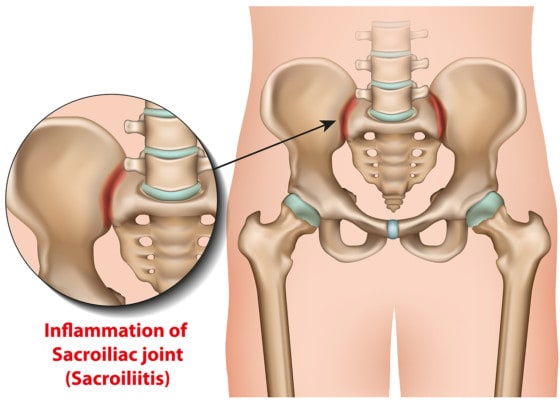The Top 3 Causes for Butt Pain
The idiom “pain in the butt” is a common one, typically used when someone or something is particularly annoying; however, butt pain is very real, and when it happens to you, it’s not only annoying but can also be severely painful and disabling.
There are three common causes we frequently see in the clinic in a patient that presents with butt pain. Let’s explore these causes and how to treat them.
1. Butt Pain Caused by Hamstrings Tendinopathy
The hamstrings are a group of muscles that live in the back of the thigh and stretch from the back of the knee to the butt. The hamstrings attach at the butt in the bone you sit on, called the ischial tuberosity. Hamstrings tendinopathy occurs when the tendon that connects the muscle to the bone becomes degenerated with wear and tear or traumatized.
How to treat hamstrings tendinopathy: If it doesn’t get better with physical therapy (PT) or with time, a precise ultrasound-guided injection of high-dose platelet rich plasma (PRP) will usually take care of the problem.
How not to treat hamstrings tendinopathy: It’s important to avoid steroid shots in the tendons as these will degenerate the tissue and deplete stem cells. Surgery is usually overkill and not recommended for the hamstrings due to its side effects and recovery time. The caveat may be when there is a large tear in the hamstrings, and it’s pulled apart like a rubber band.
2. Butt Pain Caused by SI Joint Syndrome

Medicalstocks/Shutterstock
Sacroiliac (SI) joint syndrome occurs in the lower back, between the back of the hip and the tailbone. The pain from this problem is located at the dimples of Venus (indicated with a red spot on an image in the brief video above). The pain can also radiate into the meat of the butt as well as other areas like the groin or side of the hip. The SI joint can be injured in trauma or childbirth, and it can also refer pain into the groin area.
How to treat SI joint syndrome: If it doesn’t get better with PT or chiropractic care, a precise image-guided injection of high-dose platelet rich plasma (HD-PRP) or high-dose stem cells (HD-BMC) into the joint and surrounding ligaments should do the trick. Prolotherapy also works well.
How not to treat SI joint syndrome: Avoid steroid shots for SI joint syndrome as these can injure ligament and cartilage cells as well as impact bone density, particularly in older women. Surgery to fuse the SI joint is also ill advised as, for starters, rendering the SI joint immovable overloads the lumbar spine and the hip joint and eliminates the SI joint’s shock absorbing function.
3. Butt Pain Caused by a Pinched Nerve in the Low Back
A pinched nerve in the low back may cause pain or numbness down the leg, but it also can cause butt pain without any numbness down the leg. This happens because irritated nerves in the back cause the butt muscles to misfire, leading to tendinopathy or butt pain. A pinched nerve can occur, for example, when there is a problem with a spinal disc (the cushion between the bones of the spine), such as a bulging or herniated disc, or when there is arthritis in the spine joints. In these cases, the foramen, the tunnel the nerves travel through, can narrow (foraminal stenosis), causing pinched nerves.
How not to treat a pinched nerve in the low back: Steroid shots, for the same reasons discussed in the other two diagnoses above, and surgery to treat pinched nerves really should be avoided.
Piriformis syndrome, while a rare condition, is also worth mentioning. This occurs when the piriformis muscle compresses the sciatic nerve, causing butt pain and usually numbness down the leg. The piriformis muscle sits at the geographic center of each side of the butt and stretches east to west. The reason why I don’t include Piriformis syndrome as a primary diagnosis is that it’s usually caused by either SI joint syndrome or pinched or irritated low-back nerves that supply the muscle.
The upshot? Butt pain can be caused by a number of issues, including hamstrings tendinopathy, SI joint syndrome, a pinched nerve, and even piriformis syndrome. However, with effective nonsurgical options available in regenerative medicine today, you don’t have to live with an annoying pain in the butt!

If you have questions or comments about this blog post, please email us at [email protected]
NOTE: This blog post provides general information to help the reader better understand regenerative medicine, musculoskeletal health, and related subjects. All content provided in this blog, website, or any linked materials, including text, graphics, images, patient profiles, outcomes, and information, are not intended and should not be considered or used as a substitute for medical advice, diagnosis, or treatment. Please always consult with a professional and certified healthcare provider to discuss if a treatment is right for you.